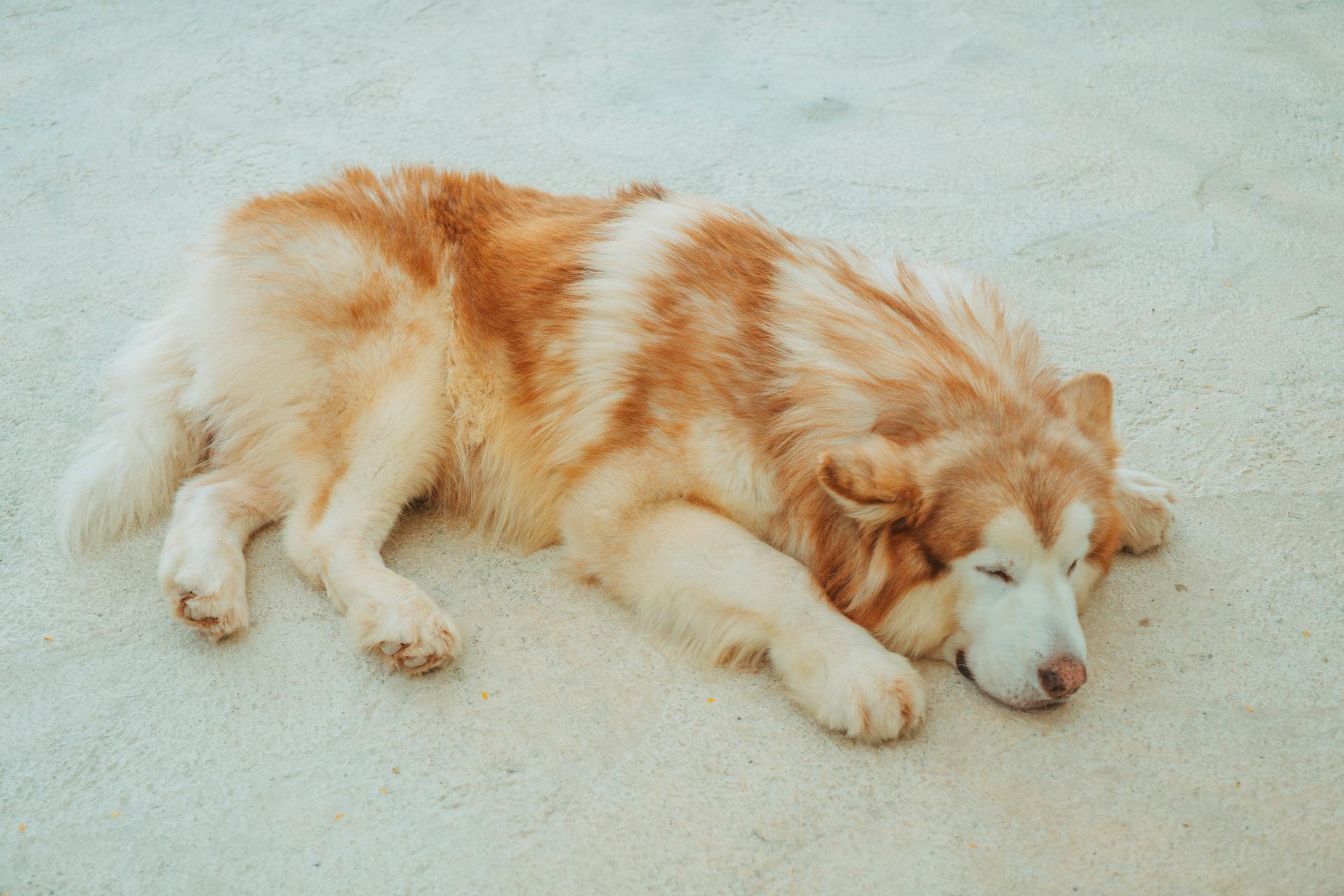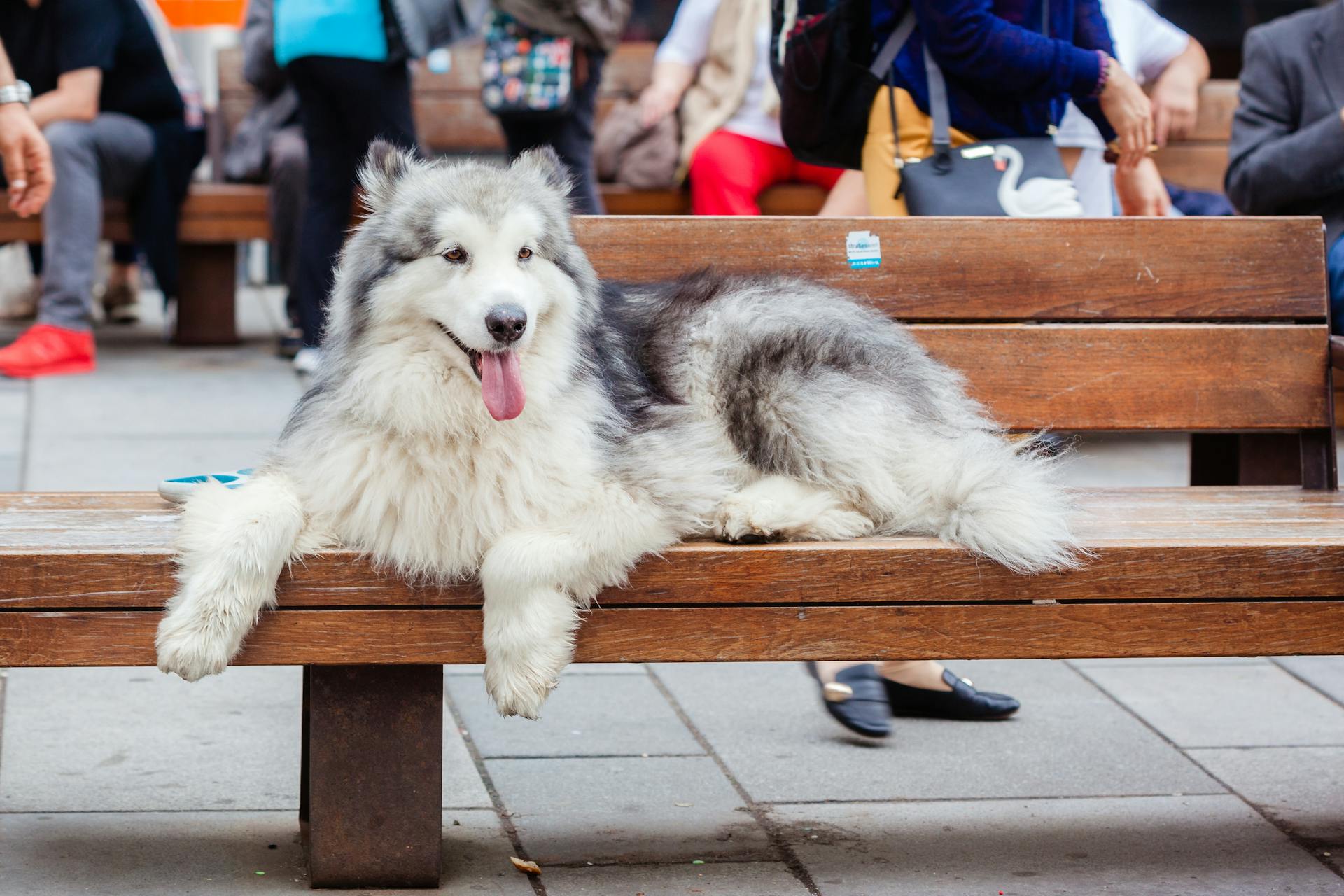
The Alaskan Malamute's origin story is a rich and fascinating one, spanning thousands of years. The breed originated from the Mahlemute people of Alaska, who valued their strength and endurance for hunting and survival.
The Mahlemute people are believed to have migrated from Siberia to Alaska over 4,000 years ago, bringing their dogs with them. These early dogs were highly valued for their ability to withstand the harsh Alaskan climate.
The Alaskan Malamute's ancestors were bred to be strong and resilient, with a thick coat and a powerful build. They were used for transportation, hunting, and even as companions.
In the early 20th century, the Alaskan Malamute was recognized as a distinct breed and was officially registered with the American Kennel Club (AKC) in 1935.
Additional reading: Perro Alaska Malamute
Origin Story
The Alaskan Malamute's origin story is a fascinating one. They were first bred by the Mahlemute people, an Inuit tribe that lived in the Arctic region of Alaska.
The Mahlemute people needed a dog that could pull heavy loads and withstand the harsh Arctic climate. They achieved this by breeding the Malamute with other dogs, such as the Eskimo dog.
These early Malamutes were incredibly strong and agile, with a thick coat that kept them warm in temperatures as low as -50°F. They were also highly intelligent and independent, making them well-suited to life in the wilderness.
The Malamute's original purpose was to help the Mahlemute people hunt and transport goods. They would often pull sleds loaded with food, supplies, and other essential items.
History of the Alaskan Malamute
The Alaskan Malamute has a rich and storied history that dates back thousands of years. They were originally bred by the Malimiut Inupiaq people of Alaska's Norton Sound region.
These dogs were highly valued for their strength, intelligence, and endurance, and were used for tasks such as hauling heavy freight across frozen landscapes. They were also used for hunting large predators like bears.
The Alaskan Malamute's history is closely tied to the indigenous peoples of Alaska, and they were an integral part of many Inupiat communities.
Early History
The Alaskan Malamute's early history is a testament to its incredible strength and versatility. The breed had a prominent role with their human companions as a utilitarian dog, working, hunting, and living alongside humans.
They were renowned for their excellent hunting abilities and were used to hunt large predators such as bears. Their interdependent relationship with their owners fostered prosperity among both and enabled them to flourish in the inhospitable land above the Arctic Circle.
The Malamute's ability to aid their owners in finding seals by alerting them to seal blowholes was just one of the many ways they proved themselves to be invaluable companions. For a brief period during the Klondike Gold Rush of 1896, the Malamute and other sled dogs became extremely valuable to recently landed prospectors and settlers.
Breed recognition came in 1935, largely through the efforts of Mrs. Eva B. Seeley, who helped establish the breed and closed the registry after a few years. The losses from service in World War II all but eliminated the breed, leaving only about 30 registered dogs in 1947.
Lineage and Ancestry
The Alaskan Malamute's lineage is a fascinating topic. The breed's ancestors arrived in the Americas around 12,000 years ago, but it wasn't until the Paleo-Eskimo people settled in the Arctic 4,500 years ago that people and their dogs began to inhabit the region.
The Malamute's origins are closely tied to Siberia, where the Malimiut Inupiaq people of Alaska's Norton Sound region are believed to have bred the breed. A study in 2013 found that the Alaskan Malamute shares a similar east Asian origin with the Greenland Dog and the Canadian Eskimo Dog.
The Malamute is considered a basal breed, predating the emergence of modern breeds in the 19th century. This means that the breed has a unique genetic makeup that sets it apart from other breeds.
A 2015 study using genetic markers found that the Malamute, the Siberian Husky, and the Alaskan Husky share a close genetic relationship with each other and with Chukotka sled-dogs from Siberia. This suggests that these breeds have a common ancestry.
DNA extracted from a 9,500-year-old dog, Zhokhov, was found to have shared a common ancestor with the Greenland sledge dog, the Alaskan Malamute, and the Siberian Husky. This ancient dog's genetic material provides a glimpse into the breed's deep history.
For another approach, see: American Eskimo Origin
The Alaskan Malamute
The Alaskan Malamute is a proud member of the working dog group, which includes breeds known for their strength, intelligence, and versatility in performing a variety of tasks.
This group encompasses breeds such as the Siberian Husky or Saint Bernard, dogs that are celebrated for their remarkable work ethic, resilience, and capacity to perform labor-intensive tasks across challenging environments.
Historically bred for hauling heavy freight across frozen landscapes, the Alaskan Malamute's primary role has always been one of partnership and perseverance.
The Alaskan Malamute shines with its incredible endurance, keen intelligence, and a gentle yet playful demeanor, making it a loyal and loving family pet.
Its remarkable work ethic and resilience are traits that it carries from its working dog heritage, allowing it to thrive in a variety of environments and situations.
The Call of the Wild
The Alaskan Malamute's strong instinct to roam free is a trait inherited from their ancestors, who were bred to pull heavy loads in the harsh Arctic environment.
Their independent nature makes them a challenge to train, but with consistent and patient efforts, they can learn to obey commands.
Originating from the Inupiat tribe in Alaska, the Malamute's ancestors were valued for their strength and endurance, often used for hunting and transportation.
Their pack mentality is a remnant of their wild ancestors, who hunted and traveled in groups to survive the unforgiving Arctic landscape.
In the wild, Malamutes would roam long distances, sometimes up to 50 miles per day, in search of food and shelter.
Their ability to adapt to extreme temperatures, from -50°F to 50°F, is a testament to their hardiness and resilience.
This natural instinct to roam has led some owners to report that their Malamutes will often try to escape if not given enough exercise and mental stimulation.
Their strong prey drive, inherited from their ancestors, makes them prone to chasing small animals if not properly socialized and trained.
The Malamute's wild ancestors were often used for hunting and tracking, skills that are still evident in their modern descendants.
A unique perspective: Alaskan Malamute Shed
Frequently Asked Questions
Do malamutes have wolf DNA?
Malamutes have a higher likelihood of carrying ancient wolf DNA due to historical interbreeding with wolves, but it's not recent. This genetic connection is reflected in their higher "wolfiness" scores.
What Indian tribe is Malamute?
The Malamute breed is named after the Mahlemuts, an Inuit tribe that originally inhabited the northwestern Alaska region. This tribe was one of the native people living in the area when Asiatic mariners first visited.
What were malamutes bred to do?
Malamutes were bred for heavy-duty tasks such as pulling sleds and carrying supplies, as well as hunting and protecting in the Arctic. Their original purpose was to thrive in harsh, freezing conditions.
What are some cool facts about malamutes?
Malamutes are known for their distinctive howling and vocal nature, as well as their ability to thrive in cold temperatures. Originally used in Arctic expeditions, they were valued for their strength, endurance, and versatility in hunting, tracking, and hauling heavy loads.
Featured Images: pexels.com


